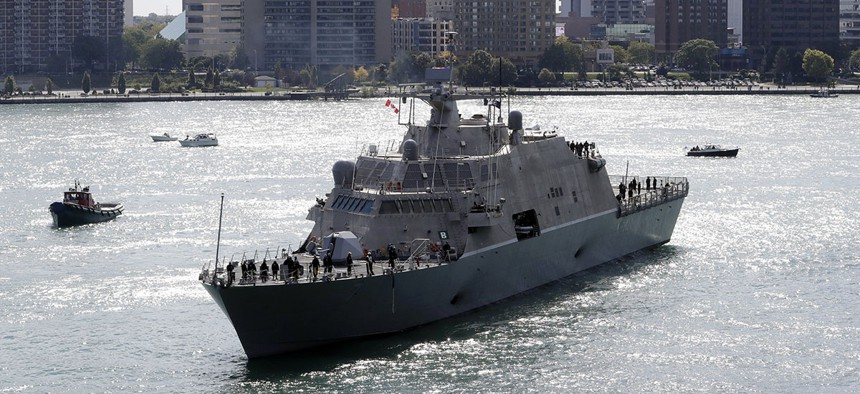How Navy’s Warship Shop Uses Data to Do More with Less

The USS Detroit, one of the United States Navy's newest warships, arrives Friday, Oct. 14, 2016, in Detroit. Carlos Osorio/AP
A Navy program office turned to an analytics and visualization tool to help explain its workforce decisions.
The U.S. Navy’s shipbuilding office has a new weapon in its effort to efficiently allocate personnel, resources and budgetary dollars: software.
The Navy’s Program Executive Office for Integrated Warfare Systems—which Chief of Staff Greg Thomas described to Nextgov as the office “that turns ships into warships”—transitioned in recent years from human intuition to a software-based approach to make complex resource and human capital allocation decisions.
Thomas said PEO IWS—which has 450 employees and oversees 60 programs and 12 lines of business, such as radar, combat systems and navigation—was drowning in complexity. Making strategic and resource allocation decisions across sometimes stovepiped organizations and defending them to overseers was becoming a major challenge. It reached a tipping point about two years ago, Thomas said.
» Get the best federal technology news and ideas delivered right to your inbox. Sign up here.
“What we wanted to do was figure out a way to get more rigor and granularity and analysis supporting why we have the people we have, and why we have them doing what we’re doing,” Thomas said.
PEO IWS turned to an analytics tool and visualization platform from Arlington, Virginia-based Decision Lens, opting for a system that allows deputy program managers to run risk-based simulations based on various input parameters. In other words, computers model where some of the agency’s budgetary and human resources ought to go and spit out visualizations regarding how singular decisions impact the organization as a whole.
For example, the software can help executives decide whether it makes sense to assign large farm teams of less experienced employees to specific projects, or whether a smaller “lean and mean” team of highly experienced professionals is better suited for the job.
It’s not just a dollars and cents that are factored in, either. Parameters might include the political sensitivity of a project or its cost, employee roles and whether functions are better left stove-piped. The software can also output where human resources should be removed and reassigned elsewhere, and what levels of exposure the organization should expect based on personnel move.
Importantly, Thomas said there’s a visual component that changes based on any input.
“Risk is quantified,” Thomas said. “We’ve got a meter, and when you make a change, you can see how the meter swings. If you add risk to the meter, it’ll swing and program managers will shy away from it. It’s taken our complexity and functions and our roles and integrated it into a single way of looking at things.”
Simulations can be run regularly to better assess short-term decisions, and Thomas said they’re also used by deputy program managers to make their case.
“Every deputy has to come in and say, ‘this is my number, this is how I’m organized, how I’ve shaped the organization and how I am now,’” Thomas said. “It’s made us more consistent and more rigorous without adding a huge burden.”
PEO IWS had an existing relationship with Decision Lens, using its software for budget prioritization, so Thomas said expanding the partnership to include big data-based human capital planning wasn’t difficult.
“We’ve taken [this software] farther on human capital than we ever did with budget prioritization,” he said. “We always felt like we were under-resourced—like we didn’t have enough people. Now, we’re able to be more efficient with that squeeze on us and making better use of the people do have.”
The Navy’s move toward a software-based approach to strategic decision-making mirrors concurrent efforts across the federal government, according to John Saaty, who co-founded Decision Lens with his brother in 2005. Saaty told Nextgov the company now sells software to 60 different federal agencies, with its status as a FedRAMP-approved software-as-a-service provider helping business.
Saaty said federal government’s enormous problem regarding waste, fraud and abuse, as well as increasingly tight budgets, have driven many agencies to turn to advanced software for strategic decision-making rather than a combination of “Microsoft Excel and people doing institutionalized manual processes and chasing their tail.”
Saaty likens the government’s challenges in strategic decision-making to those faced by professional sports teams. The team could draft a player based on hunches and limited data provided by scouts, or it could input a collection of quantitative data (such as 40-yard-dash time) and qualitative information (leadership skills, fit with team or behavior) “to prioritize what is best for the team and select the best player in the draft.”
Government, Saaty said, can do the same thing, “matching up talent with their most important, complex programs.”






